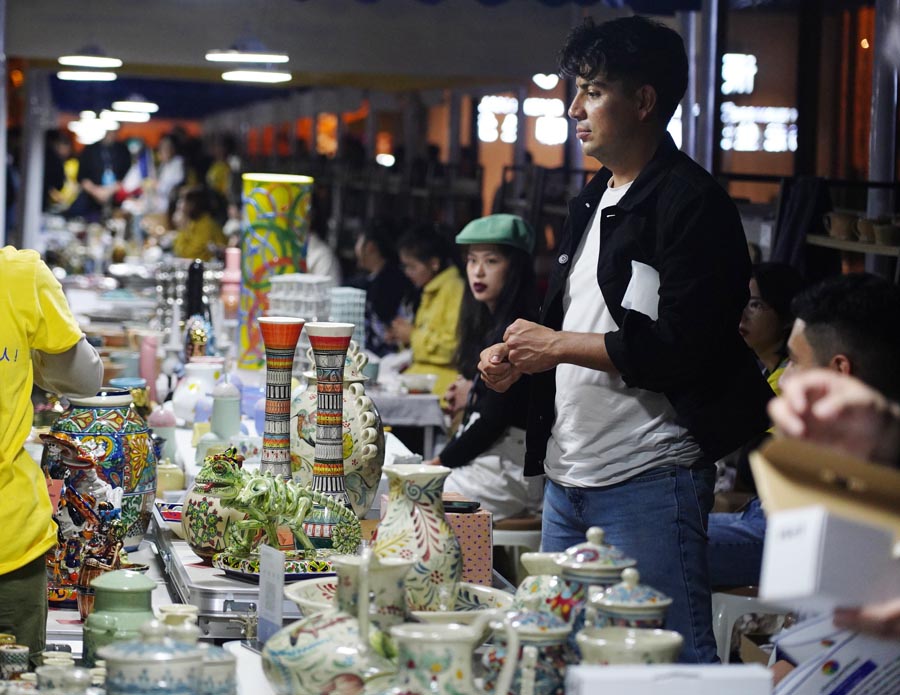China's porcelain capital attracting more craftsmen for ideas, skills exchange
 0 Comment(s)
0 Comment(s) Print
Print E-mail Xinhua, October 23, 2019
E-mail Xinhua, October 23, 2019

Porcelain craftsmen from home and abroad said the plan of building Jingdezhen, a Chinese city renowned for its over 1,700-year history of porcelain making, into a world ceramic cultural center, will attract more skilled craftsmen to introduce new ideas, strengthen exchange and stimulate the development of the ceramic industry.
In early October, the government of eastern China's Jiangxi Province unveiled details of a newly-released plan of building Jingdezhen into a national ceramic culture inheritance and innovation pilot zone. One of its primary missions is to enhance international ceramic cultural exchange and cooperation.
"It's nice and interesting to me, and also for all international artists who come here, to exchange thoughts and ideas on each other's works. Every person from Europe, Africa, America and Russia, has come here to experience Chinese culture and learn from the Chinese," said Christiane Toewe, a German ceramic artist who has visited Jingdezhen three times in recent years.
"At home, I have a big workspace, but it is refreshing to take a break, come here for three months and work on new projects," Toewe said.
As one of the areas with the highest concentration of artistic talents in China, Jingdezhen has over 30,000 artists, including 5,000 foreigners, living in the city. These artists are known as "jingpiao" and foreigners as "yangjingpiao."
Moreover, the city now boasts more than 6,700 ceramic enterprises and workshops. Some 150,000 people work in porcelain-related industries.
Japanese ceramist Takeshi Yasuda and his wife, who have lived in the city for 17 years, are two of the thousands of "yangjingpiao." For them, Jingdezhen is not only their creation base but also their second hometown.
In Yasuda's eyes, foreign artists chose to come to Jingdezhen as it is a place where they can learn advanced skills in craftsmanship. In addition, artists are able to aquire precious materials and equipment to turn their visions into reality, which is sometimes difficult to achieve in their own countries.
"Jingdezhen is a spectacle. You have new discoveries here every year. Its well-developed industry environment has attracted many young artists to start their business and create their own works, " said Yasuda.
As the city speeds up to transform itself into a world ceramic cultural center by 2035, Yasuda said Jingdezhen is taking a new development path. "The future of Jingdezhen will be brighter as it is building cultural confidence at a higher and more international level."
Lee Taxoo, a ceramic artist from the Republic of Korea, will spend three to four months every year collecting porcelain fragments in Jingdezhen. He splices the pieces into new ceramic works at the bottom of old bowls, which he has named "Rebirth."
"Jingdezhen is a special place for porcelain artists. It has a long history of hand-made ceramics, which is important for the ceramic cultural inheritance," said Lee. "In China, I have more opportunities to exchange with global artists on my design ideas and works."
According to the plan, more high-level porcelain talents will be introduced to Jingdezhen, and both domestic and foreign institutions of scientific research, art and think tanks are encouraged to establish branches in the pilot zone.
More preferential policies tailored for talents, such as housing, resettlement of their spouses and children's education, as well as loans for start-ups, will be rolled out.
"Jingdezhen is an inclusive city, with skilled craftsmen from all over the world gathering here," said local porcelain artist Zeng Yalin. "The pilot zone will bring historical opportunities for the city, which expects to attract more artists from home and abroad to exchange new ideas and craftsmanship and stimulate the development of the ceramic industry."






Go to Forum >>0 Comment(s)